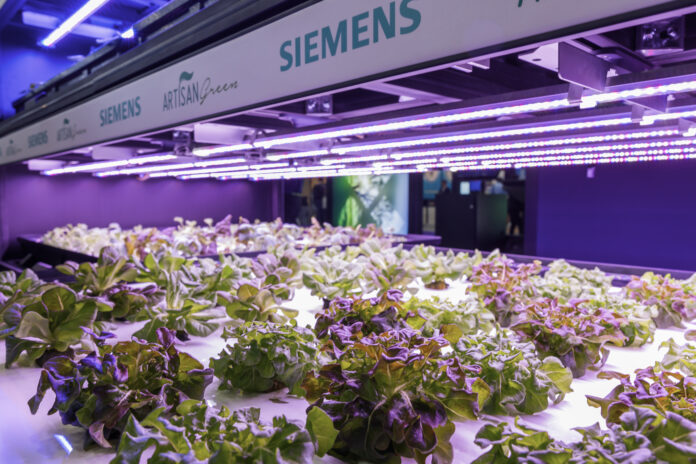In the first instalment of our two-part feature, SMEhorizon spoke with Ray Poh, Founder and Managing Director of Artisan Green, on his company’s partnership with Siemens, and how technology has enabled them to meet both productivity and sustainability goals. Isabel Chong, Head of Digital Industries for ASEAN at Siemens also weighed in on Singapore’s Agriculture sector, and how digitalisation and automation can assist SMEs more generally.
However, innovation is never solely about installing the new hardware and its accompanying software. The human element, such as processes, procedures, and continuity measures is also a critical factor.
The conversation continues with Poh’s sharing of Artisan Green’s key technical challenges adapting to the new technology, and his company’s ambitions for the future. Chong reflects on the lessons that this implementation can provide for other companies seeking to leverage digitalisation and automation.
What were the key technical challenges you experienced in the transition to Siemens’ Farm Management System? How were these challenges addressed to ensure a smooth implementation?
[Ray Poh] One of the key challenges we anticipate is rapidly establishing procedures for handling system errors and system downtime. In many projects, we think most of the planning and training focuses on bringing up production and how to handle the system when it’s working.
With a Farm Management System, there is the possibility of losing critical pieces of data if serious errors occur and this could lead to production downtime or slowdowns. In an environment where there are multiple technologies and equipment all working together, it is important that we devise ways to efficiently and effectively supervise and monitor all the systems, sub-systems and hardware to ensure we don’t have errors and problems building up silently. We need to establish our procedures and processes for system and equipment checks to ensure minimal downtime.
Much of the key learnings and procedures will likely come about only as we go through and experience the actual errors and downtime. However, we plan to mitigate the effects of these system errors through extensive downtime scenario planning and mapping out contingencies.
Part of the work that we need to do will involve speaking with our equipment and system providers, laying out the hardware and systems lists and asking questions like “what happens if this item fails?”, “how does the system alert us if this item fails?”, “what is our back up if this system module fails?”.
In other words, our strategy is to plan two steps ahead and work to achieve a thorough understanding of every single piece of technology and equipment we work with.
What can be done to improve the adoption of digital and automated processes amongst local companies?
[Isabel Chong] One of the things that local companies can do is to invest in education and training to ensure that their employees have the skills and knowledge needed to operate digital and automated processes effectively. They can participate in the training programmes provided by the Singapore government and tech companies.
To ensure that digitalisation and automation is successful in the long-run, nurturing the next generation of talent in the industrial edge computing space is key.
What technologies or innovations does Artisan Green plan to adopt in the future? Could you give us an insight into Artisan Green’s tech roadmap for the next couple of years, especially in the light of Singapore’s 30 by 30 plan?
[RP] After our new farm has been established and our production targets have been met, we would have achieved what we originally set out to do – which is to achieve scale at a level of efficiency which makes urban farming in Singapore a financially sustainable enterprise.
The next stage is to focus on improving our operations and generating more efficiencies in our ongoing operations. In other words, our aim would be to eke out every possible efficiency we can.
On the operations side of things, we will look into equipment that helps us produce and process those large volumes even more efficiently. We already have plans for machinery that help us weigh and fill bags of produce many times faster than manual labourers. It might also make sense for us to invest in machinery that helps us put those packs into carton boxes. Can we invest in a cold room pallet racking technology that automatically reads the contents of carton boxes, and sorts and stores those boxes?
We’ll be studying our operations to establish our new pain points and evaluate whether they need to be addressed with new processes, or new technology. Part of the learning journey will be to study what new technologies are available in the market, and to evaluate their value for our own food manufacturing operations.
On the growing side of the equation, can we produce higher volumes with the same amount of space? Can we improve the taste and nutritional value of our products? I believe there are still greater volumes we can unlock from our growing system. There is no magic bullet here other than putting in the work to plan, research, conduct trials and experiment with all our inputs. To aid us in this effort, we’ll be establishing a data lake where we store all of the growing area’s data, sensor inputs from all our equipment and systems, as well as images of our plants.
As the farm’s operations progress, we’ll be able to conduct deep analyses of our operations and our production processes. We’ll compare the costs and benefits of doing this on the cloud, over having our own storage and servers on-premise to process our data.
What advice do you have for companies seeking ways to digitalise and automate their processes?
[IC] It is important to start with a clear strategy and align it with the goals of your company, while understanding the constraints including budget and manpower that may hinder the implementation and find suitable solutions. It is also crucial to identify a specific area that you would like to digitalise and automate, start with small pilot projects, and ask for feedback from the team to improve and progressively scale up.
Ultimately, digitalisation and automation is not something that can be done within a day – it is a continuous journey that requires a trial-and-error approach, internal discussion and planning to yield effective results.














